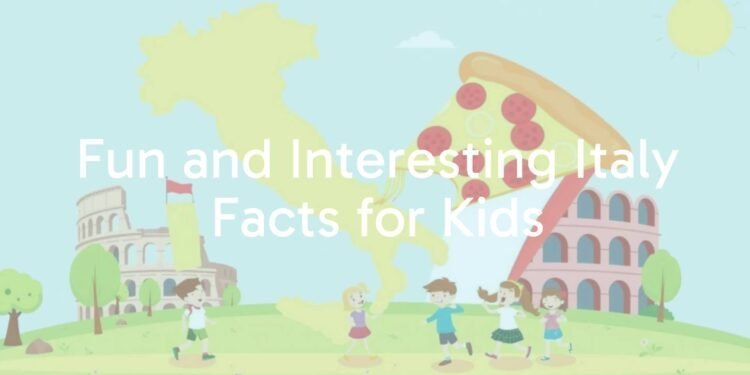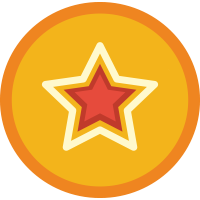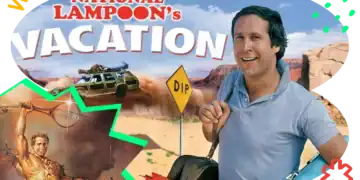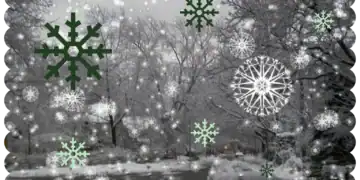Ready to learn about a place filled with ancient history, tasty food, and amazing views? Italy, often called “Bel Paese,” which means “beautiful country,” is a wonderful place! From its boot shape to its busy cities and peaceful villages, Italy is full of cool facts that might make you want to visit. Let’s explore this European treasure, its people, its animals, and more!
Italy isn’t just famous for pizza and pasta (we’ll talk about those yummy foods soon!). It’s a country that has influenced art, science, and even fashion around the globe. So, let’s learn more about Italy and find out some of its most exciting facts!
Quick facts about Italy
Here are some quick facts to start! Italy’s official name is the Italian Republic, or Repubblica Italiana. The capital is Rome, a huge and historic city with about 4.3 million people. The whole country has around 59 million people as of 2024. The official language is Italian, and the currency is the Euro. Before 2001, people used the Italian lira.
Italy became one nation in 1861. Before that, it was made up of separate kingdoms and city-states. Its history goes back thousands of years. More than 98% of Italians can read and write. Most Italians are Christians, mainly Roman Catholics. Vatican City, the smallest country in the world and the center of the Catholic Church, sits inside Rome!
What makes Italy unique?
What makes Italy special? Its map shape is easy to spot-it looks like a high-heeled boot! If you look near the “toe,” you’ll see Sicily, which looks like a ball the boot is kicking. This shape and location have mattered a lot in history and culture.
Italy is also a mix of old traditions and modern life. City centers are lively and up to date, but families still keep long-held customs and values. Art, buildings, and food are big parts of daily life. From stunning scenery to important inventions and creative people, Italy truly lives up to its nickname, “Bel Paese.”
Where is Italy Located?
Italy is in Southern Europe, in the middle of the Mediterranean Sea. This great location has been very important through history, linking it to ancient cultures and trade routes. It’s in a perfect spot to connect with many places.
Map of Italy
Look at a map of Europe and you’ll spot Italy by its boot shape. This “boot” is a peninsula, which means water surrounds it on three sides. To the south is the big island of Sicily, and to the west is another large island called Sardegna. These islands are part of Italy too, giving it even more coastline.
Italy is a good-sized country, a bit bigger than the UK, the Netherlands, and Belgium combined, and similar in size to Arizona in the USA. Its coastline is over 7,600 km (4,722 miles) long, with pretty ports, scenic lakes, and sandy beaches.
Neighboring countries and seas
Italy borders six countries on land. To the north are France, Switzerland, Austria, and Slovenia. There are also two tiny countries inside Italy: Vatican City, within Rome, and San Marino in the north. These fully enclosed countries are called enclaves.
Several seas surround Italy. To the east is the Adriatic Sea. Along the west are the Ligurian Sea and the Tyrrhenian Sea. To the south is the Ionian Sea. These seas help create different local weather and beautiful coasts, great for sailing, swimming, and exploring.
Italy’s Geography and Landscape
Italy has a mix of tall mountains, rolling hills, flat plains, and long coastlines. You can ski in the snowy Alps and also relax on a sunny beach, all in the same country.
Regions and climate in Italy
Because Italy stretches far from north to south and has many mountains, the weather changes a lot by region. Most areas have a Mediterranean climate, with warm summers and cool, wet winters. In the north, especially in the mountains, winters are colder and snowy-great for skiing.
Italy is divided into regions with their own character. In the north, the Alps dominate the view. Moving south, the land flattens into the Po Valley, a key area for farms and factories. Further down the “boot,” the Apennines run like a spine and create hilly areas such as Tuscany. The south is hotter and drier, with fertile land for olives, almonds, and figs.
Volcanoes and interesting geography
Italy has active volcanoes! Three famous ones are Mount Vesuvius near Naples, Mount Etna on Sicily, and Stromboli on an island nearby. Mount Etna is the largest volcano in Europe and very active.
Mount Vesuvius erupted in 79 A.D. and buried the Roman city of Pompeii in ash, preserving it and giving us a great look at ancient life. Italy also includes the big islands of Sicily and Sardegna, plus many smaller islands like Capri, Ischia, and Elba. Some, such as Lampedusa and Lampione, are closer to Africa than to mainland Italy.
Famous landmarks and natural wonders
Italy has breathtaking natural sights. The Alps in the north include the highest mountains in the country, such as Monte Bianco (Mont Blanc) at 4,807 meters (15,776 feet). The Dolomites, part of the Alps, are striking with sharp peaks and are popular for skiing and hiking.
Northern Italy also has beautiful lakes, with Lake Garda being the largest. It’s known for strong winds that attract surfers. The Po River, Italy’s longest, flows 652 km (405 miles) across the northern plains. With many coves, cliffs, and beaches, the long coast offers endless scenery for nature lovers.
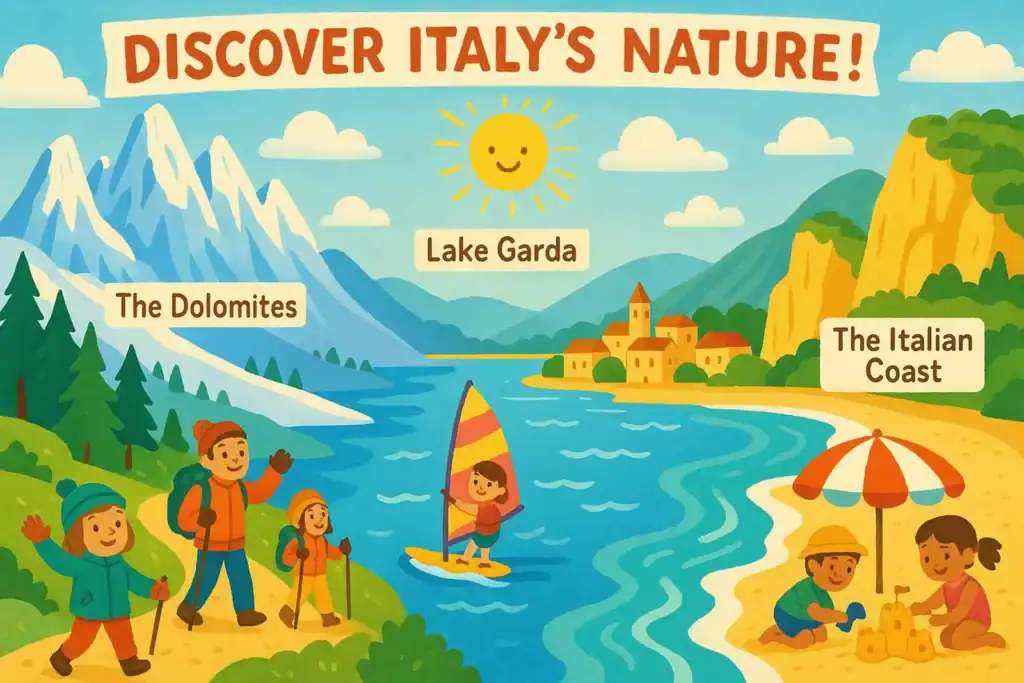
Animals and Nature in Italy
Italy has ancient ruins and great food, and it is also home to many plants and animals. About one-third of all European animal species and half of all European plant species live here. Some species are found only in Italy.
Native animals and birds
Italy has about 100 mammal species and over 500 bird species. Rare animals include the Sardinian deer and the Corsican hare. In the Alps, you might spot marmots, which are ground squirrels with loud calls. In very wild areas, you might even see a lynx, a wild cat with ear tufts.
The Italian grey wolf is one of the most famous animals. It almost disappeared due to hunting and habitat loss, but it has made a comeback thanks to protection. Brown bears are also protected, with a small wild population. Italy has 20 national parks and 16 Marine Reserves to help protect species such as the Italian shark and the Italian wolf.
National symbols of Italy
The Italian grey wolf is an unofficial national animal that stands for strength and pride, a symbol linked to Roman myths. Italy’s national flowers are the red rose and the white lily. Both are beautiful and meaningful.
The Italian flag, the “Tricolore,” has three vertical stripes: green, white, and red. These colors are said to stand for hope (green), faith (white), and charity (red). Another symbol is a white five-pointed star with a thin red border, often shown with the flag. These symbols reflect Italy’s identity and history.
Famous Cities and Attractions
Italy is like a giant outdoor museum, full of cities known for history, art, and charm. Whether you love ancient ruins, quiet canals, or Renaissance art, there’s a city you’ll enjoy.
Rome, Venice, and Florence
The capital, Rome, is called the “Eternal City” for its long history. Ancient ruins stand near modern streets. Venice is a special city built on 120 islands, with canals instead of roads. It’s known as “Lagoon City” and “The City of Masks,” famous for gondolas and colorful Carnival events.
Florence, or Firenze, is the capital of Tuscany and a center of art and architecture. It’s known as the birthplace of the Renaissance. Great artists like Michelangelo and Leonardo da Vinci lived and worked here, leaving many masterpieces.
The Colosseum, Leaning Tower of Pisa, and more
Some landmarks are known worldwide. In Rome, the mighty Colosseum is an ancient arena where gladiators fought. Nearby is the Roman Forum (Foro Romano), the center of ancient Rome. In Vatican City, you can visit St. Peter’s Basilica.
In Pisa, you’ll find the famous Leaning Tower of Pisa, a bell tower from the 12th century that leans to one side. In Ravenna, churches are decorated with bright mosaics from the 5th century, when it was a key center of Roman Christian art. In the south, the town of Alberobello has unique stone houses with cone roofs called trulli.
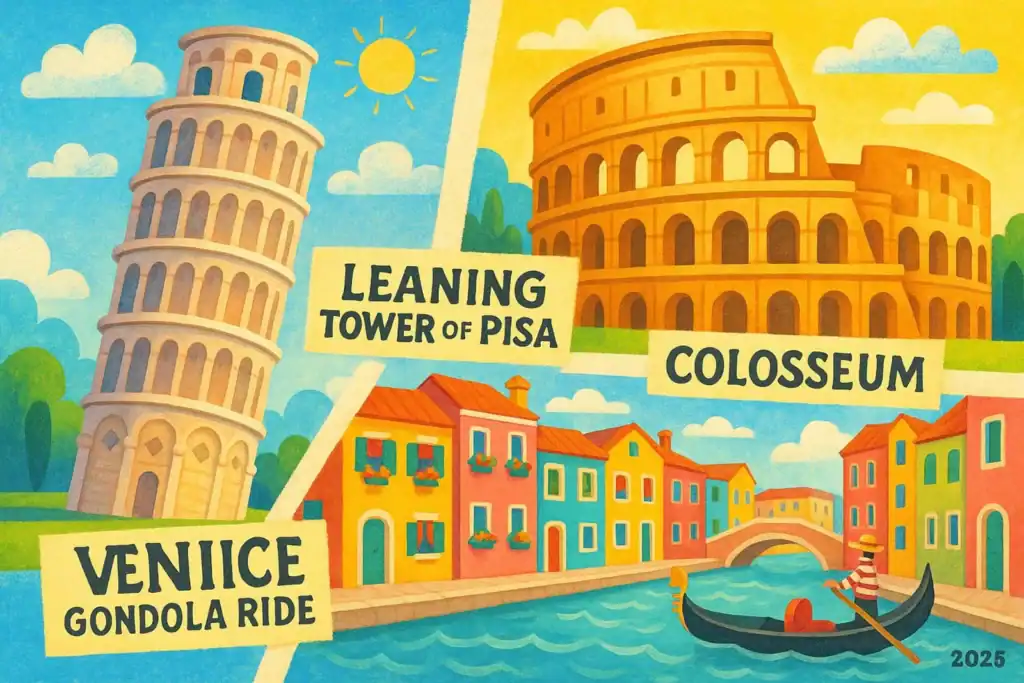
Special places just for kids
Many Italian sights are fun for all ages, and some are extra exciting for kids. Walking through the Colosseum and imagining gladiators brings history to life. Riding a gondola in Venice is a one-of-a-kind trip. Climbing the Leaning Tower of Pisa (if you’re old enough and brave enough!) is a special experience.
Cities have parks and piazzas (main squares) where kids can play. Trying different flavors of gelato is a tasty adventure. Some areas even offer farm stays where kids can learn about animals and rural life. And eating pizza in its birthplace is a treat any child will love.
Italian People and Their Culture
Italy’s spirit comes from its people and their lively culture. Italians value passion, family, and enjoying life. Traditions, festivals, and community are at the center of daily living.
Family life and traditions in Italy
Family is very important. Big families with grandparents, parents, and kids often live together. Because of this, many young adults live at home into their 30s, even with a job. When parents retire, they may move in with their children, keeping families close.
People meet with family and friends in the piazza, the main square of a town or village. These squares are lively places to talk and relax. Food is a big part of family life. Fresh meals are often cooked by “la mama” (mother) or “nonna” (grandmother), with recipes passed down through the years.
National holidays and fun celebrations
Italy loves a good celebration. One major national holiday is Festa della Repubblica, or Republic Day, on June 2. It marks the start of the Italian Republic in 1946.
There are many yearly festivals. Carnival before Lent is famous, especially the Carnival of Venice, which began in the 12th century and features masks and costumes. The Palio in Siena is a thrilling horse race held in the main square, dating back to 1644. These events bring Italian history and culture to life.
Popular sports and hobbies
Italians love sports, especially soccer-called calcio. The national team has won the World Cup four times, most recently in 2006. Fans follow clubs like Inter Milan, Lazio Roma, and Juventus Turin with great passion.
People also enjoy skiing in the Alps and cycling, with big races like the Giro d’Italia. Water sports, such as surfing, are common along the long coast. Many also follow motor racing, especially Formula 1. In Florence, there is even a historic and very intense match called Calcio storico played once a year.
What Language Do People Speak in Italy?
The main language in Italy is Italian. It has a musical sound, which is one reason it is popular in opera and pop music. There’s more to it than a pretty sound, though.
Interesting facts about the Italian language
Italian is a Romance language that grew from Latin, the language of the ancient Romans. It shares a lot with other Romance languages like French and Spanish. Italian shares about 89% of its words with French and 82% with Spanish.
The Italian alphabet has only 21 letters. The letters ‘j’, ‘k’, ‘w’, ‘x’, and ‘y’ usually appear only in borrowed words. While Italian is the official language, some northern regions also use minority languages such as German, French, and Ladin. Most young people study English, French, or German in school, which helps visitors communicate.
Italian words kids might know
You may already know some Italian words, especially for food and music. Here are a few:
- Ciao! (pronounced: chow) – Means “hello” and “goodbye.”
- Grazie (pronounced: grah-tsee-eh) – Means “thank you.”
- Pizza (pronounced: peet-sah) – A favorite food.
- Pasta (pronounced: pah-stah) – Another well-known dish.
- Gelato (pronounced: jeh-lah-toh) – Italian ice cream.
- Espresso (pronounced: eh-spres-soh) – A small, strong coffee.
- Calcio (pronounced: kahl-cho) – The word for soccer.
- Bravo! (pronounced: brah-voh) – Means “well done!”
Learning a few words is a fun way to connect with Italy and surprise your friends.
Italian Food Kids Love
Italian food is famous worldwide. From savory dishes to sweet desserts, Italian cooking is full of flavor. Many dishes are kid favorites too.
Pizza, pasta, and other favorite dishes
The biggest stars are pizza and pasta. Pizza likely began in Naples around 1860. In Italy, it’s usually thin, baked in a wood-fired oven, and topped with fresh ingredients like vegetables, thin ham, salami, artichokes, or olives. There are over 100,000 pizza makers in Italy, making about one million pizzas each day.
Pasta is world-famous, with more than 200 shapes. Long, thin spaghetti with sauce is a classic, and layered lasagna with cheese and meat is another favorite. Many dishes use fresh vegetables and seafood. Kids also enjoy Calzone, a folded pizza bread filled with tasty ingredients, and Pesto, a thick green sauce made with herbs, olive oil, and cheese.
Unique Italian desserts
No Italian meal feels complete without something sweet. The most famous dessert is Gelato, Italian ice cream. It’s creamier and has stronger flavors than regular ice cream. Gelato shops, called gelaterias, offer many flavors.
Other desserts include Panettone, a sweet bread with raisins, often eaten during holidays; Panforte, a firm fruit cake; and Amaretti, almond cookies. These treats are perfect after a meal or as a snack.
Famous Italians through History
Italy has given the world many great thinkers and artists. Explorers, painters, and scientists from Italy have shaped history in big ways.
Artists, scientists, and inventors from Italy
Leonardo da Vinci was a famous painter who created the Mona Lisa, and he was also a skilled scientist and inventor. He even suggested early on that the Earth is round. Michelangelo was another giant of art, known for his sculptures and the Sistine Chapel ceiling.
In exploration, Italians led the way. Christopher Columbus and Amerigo Vespucci traveled across the Atlantic, and Marco Polo journeyed far across Asia. Galileo Galilei made major advances in astronomy. Italians also invented important tools: Bartolomeo Cristofori built the first piano around 1700, and the thermometer has Italian roots. Alessandro Volta worked on electricity, and the unit “volt” is named after him.
Modern-day Italian stars
Italy still produces famous people today. In fashion, designers like Gianni Versace built iconic brands. In sports, soccer greats like goalkeeper Gianluigi Buffon inspire fans. In music, opera singer Luciano Pavarotti wowed audiences with his powerful voice. These stars continue Italy’s long tradition of talent and creativity.
Surprising and Fun Italy Trivia
There’s always more to learn about Italy, from tiny neighbors to fun customs and record-breaking facts.
Weird laws and surprising customs
Italy surrounds two of the world’s smallest countries. San Marino, in northern Italy, is the oldest republic. Vatican City, in Rome, is the smallest country on Earth. Both have their own governments and laws.
A fun table rule: Italians eat spaghetti with a fork only-no spoon. In Rome, people toss coins into the Trevi Fountain. About $24,000 lands there every day, and the money goes to charity. It’s a kind tradition that helps others.
Record-breaking Italy facts
The University of Rome is among the world’s largest, with about 150,000 students.
We mentioned Mount Etna as Europe’s biggest volcano. Here’s a reminder: it is huge-about two and a half times larger than Mount Vesuvius. Italy also has the longest border with Switzerland at 698 km (434 miles). And here’s a fun fact: denim jeans started in Italy. They trace back to Genoa in the 1600s, and the word “jeans” likely comes from “Genes,” the French name for Genoa.
Discover More about Italy
Italy sparks curiosity, and there’s always more to learn. Whether you want to visit someday or just enjoy learning at home, you can keep exploring in many ways.
Books, games, and resources for kids
To learn more about Italy, check your library or bookstore. Look for children’s books about Roman history, famous artists like Leonardo da Vinci, or stories set in Venice and Florence. Many books mix facts with fun stories to make learning enjoyable.
Online, you can find educational websites and videos with virtual tours of landmarks, simple Italian phrases, and easy recipes. There are also games and puzzles about Italian culture and geography. Studying maps and locating mountains, rivers, and cities is a great way to learn too. The more you explore, the more you’ll appreciate Italy’s amazing stories and achievements.

